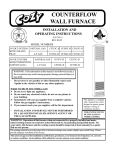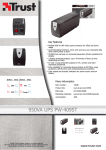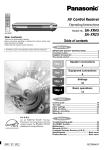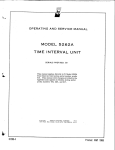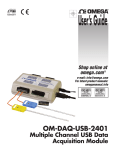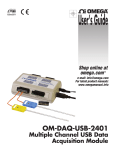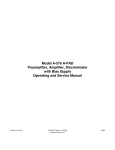Download Model 419 Precision Pulse Generator Operating and Service Manual
Transcript
Model 419
Precision Pulse Generator
Operating and Service Manual
Printed in U.S.A.
ORTEC® Part No. 733180
Manual Revision C
1202
Advanced Measurement Technology, Inc.
a/k/a/ ORTEC®, a subsidiary of AMETEK®, Inc.
WARRANTY
ORTEC* warrants that the items will be delivered free from defects in material or workmanship. ORTEC makes
no other warranties, express or implied, and specifically NO WARRANTY OF MERCHANTABILITY OR
FITNESS FOR A PARTICULAR PURPOSE.
ORTEC’s exclusive liability is limited to repairing or replacing at ORTEC’s option, items found by ORTEC to
be defective in workmanship or materials within one year from the date of delivery. ORTEC’s liability on any
claim of any kind, including negligence, loss, or damages arising out of, connected with, or from the performance
or breach thereof, or from the manufacture, sale, delivery, resale, repair, or use of any item or services covered
by this agreement or purchase order, shall in no case exceed the price allocable to the item or service furnished
or any part thereof that gives rise to the claim. In the event ORTEC fails to manufacture or deliver items called
for in this agreement or purchase order, ORTEC’s exclusive liability and buyer’s exclusive remedy shall be release
of the buyer from the obligation to pay the purchase price. In no event shall ORTEC be liable for special or
consequential damages.
Quality Control
Before being approved for shipment, each ORTEC instrument must pass a stringent set of quality control tests
designed to expose any flaws in materials or workmanship. Permanent records of these tests are maintained for
use in warranty repair and as a source of statistical information for design improvements.
Repair Service
If it becomes necessary to return this instrument for repair, it is essential that Customer Services be contacted in
advance of its return so that a Return Authorization Number can be assigned to the unit. Also, ORTEC must be
informed, either in writing, by telephone [(865) 482-4411] or by facsimile transmission [(865) 483-2133], of the
nature of the fault of the instrument being returned and of the model, serial, and revision ("Rev" on rear panel)
numbers. Failure to do so may cause unnecessary delays in getting the unit repaired. The ORTEC standard
procedure requires that instruments returned for repair pass the same quality control tests that are used for
new-production instruments. Instruments that are returned should be packed so that they will withstand normal
transit handling and must be shipped PREPAID via Air Parcel Post or United Parcel Service to the designated
ORTEC repair center. The address label and the package should include the Return Authorization Number
assigned. Instruments being returned that are damaged in transit due to inadequate packing will be repaired at the
sender's expense, and it will be the sender's responsibility to make claim with the shipper. Instruments not in
warranty should follow the same procedure and ORTEC will provide a quotation.
Damage in Transit
Shipments should be examined immediately upon receipt for evidence of external or concealed damage. The carrier
making delivery should be notified immediately of any such damage, since the carrier is normally liable for damage
in shipment. Packing materials, waybills, and other such documentation should be preserved in order to establish
claims. After such notification to the carrier, please notify ORTEC of the circumstances so that assistance can be
provided in making damage claims and in providing replacement equipment, if necessary.
Copyright © 2002, Advanced Measurement Technology, Inc. All rights reserved.
*ORTEC® is a registered trademark of Advanced Measurement Technology, Inc. All other trademarks used
herein are the property of their respective owners.
iii
CONTENTS
WARRANTY . . . . . . . . . . . . . . . . . . . . . . . . . . . . . . . . . . . . . . . . . . . . . . . . . . . . . . . . . . . . . . . . . . . . . . . ii
SAFETY INSTRUCTIONS AND SYMBOLS . . . . . . . . . . . . . . . . . . . . . . . . . . . . . . . . . . . . . . . . . . . . . . . iv
SAFETY WARNINGS AND CLEANING INSTRUCTIONS . . . . . . . . . . . . . . . . . . . . . . . . . . . . . . . . . . . . . v
1. DESCRIPTION . . . . . . . . . . . . . . . . . . . . . . . . . . . . . . . . . . . . . . . . . . . . . . . . . . . . . . . . . . . . . . . . . . . 1
1.1. GENERAL . . . . . . . . . . . . . . . . . . . . . . . . . . . . . . . . . . . . . . . . . . . . . . . . . . . . . . . . . . . . . . . . 1
1.2. BASIC FUNCTION . . . . . . . . . . . . . . . . . . . . . . . . . . . . . . . . . . . . . . . . . . . . . . . . . . . . . . . . . . 1
2. SPECIFICATIONS . . . . . . . . . . . . . . . . . . . . . . . . . . . . . . . . . . . . . . . . . . . . . . . . . . . . . . . . . . . . . . . . 2
3. INSTALLATION . . . . . . . . . . . . . . . . . . . . . . . . . . . . . . . . . . . . . . . . . . . . . . . . . . . . . . . . . . . . . . . . . .
3.1. GENERAL . . . . . . . . . . . . . . . . . . . . . . . . . . . . . . . . . . . . . . . . . . . . . . . . . . . . . . . . . . . . . . . .
3.2. CONNECTION TO POWER . . . . . . . . . . . . . . . . . . . . . . . . . . . . . . . . . . . . . . . . . . . . . . . . . . .
3.3. USE OF EXTERNAL REFERENCE VOLTAGE - EXTERNAL/INTERNAL REFERENCE
SWITCH . . . . . . . . . . . . . . . . . . . . . . . . . . . . . . . . . . . . . . . . . . . . . . . . . . . . . . . . . . . . . . . . .
3.4. LINEAR OUTPUT SIGNAL CONNECTIONS AND TERMINATING IMPEDANCE
CONSIDERATIONS . . . . . . . . . . . . . . . . . . . . . . . . . . . . . . . . . . . . . . . . . . . . . . . . . . . . . . . . .
3
3
3
4. OPERATING INSTRUCTIONS . . . . . . . . . . . . . . . . . . . . . . . . . . . . . . . . . . . . . . . . . . . . . . . . . . . . . . .
4.1. PANEL CONTROLS . . . . . . . . . . . . . . . . . . . . . . . . . . . . . . . . . . . . . . . . . . . . . . . . . . . . . . . . .
4.2. CONNECTOR DATA . . . . . . . . . . . . . . . . . . . . . . . . . . . . . . . . . . . . . . . . . . . . . . . . . . . . . . . .
4.3. TYPICAL OPERATING CONSIDERATIONS . . . . . . . . . . . . . . . . . . . . . . . . . . . . . . . . . . . . . .
4
4
5
5
5. MAINTENANCE . . . . . . . . . . . . . . . . . . . . . . . . . . . . . . . . . . . . . . . . . . . . . . . . . . . . . . . . . . . . . . . . .
5.1. TESTING PERFORMANCE OF THE PULSE GENERATOR . . . . . . . . . . . . . . . . . . . . . . . . .
5.2. ADJUSTMENT OF INTERNAL OSCILLATOR FREQUENCY . . . . . . . . . . . . . . . . . . . . . . . . .
5.3. ADJUSTMENT OF DECAY TIME OF OUTPUT PULSE . . . . . . . . . . . . . . . . . . . . . . . . . . . . .
5.4. TABULATED TEST POINT VOLTAGES . . . . . . . . . . . . . . . . . . . . . . . . . . . . . . . . . . . . . . . .
5.5. SUGGESTIONS FOR TROUBLESHOOTING . . . . . . . . . . . . . . . . . . . . . . . . . . . . . . . . . . . .
10
10
11
11
12
12
3
3
iv
SAFETY INSTRUCTIONS AND SYMBOLS
This manual contains up to three levels of safety instructions that must be observed in order to avoid
personal injury and/or damage to equipment or other property. These are:
DANGER
Indicates a hazard that could result in death or serious bodily harm if the safety instruction
is not observed.
WARNING
Indicates a hazard that could result in bodily harm if the safety instruction is not observed.
CAUTION
Indicates a hazard that could result in property damage if the safety instruction is not
observed.
Please read all safety instructions carefully and make sure you understand them fully before attempting to
use this product.
In addition, the following symbol may appear on the product:
ATTENTION–Refer to Manual
DANGER–High Voltage
Please read all safety instructions carefully and make sure you understand them fully before attempting to
use this product.
v
SAFETY WARNINGS AND CLEANING INSTRUCTIONS
DANGER
Opening the cover of this instrument is likely to expose dangerous voltages. Disconnect the
instrument from all voltage sources while it is being opened.
WARNING Using this instrument in a manner not specified by the manufacturer may impair the
protection provided by the instrument.
Cleaning Instructions
To clean the instrument exterior:
! Unplug the instrument from the ac power supply.
! Remove loose dust on the outside of the instrument with a lint-free cloth.
! Remove remaining dirt with a lint-free cloth dampened in a general-purpose detergent and water
solution. Do not use abrasive cleaners.
CAUTION To prevent moisture inside of the instrument during external cleaning, use only enough liquid
to dampen the cloth or applicator.
!
Allow the instrument to dry completely before reconnecting it to the power source.
vi
1
ORTEC MODEL 419
PRECISION PULSE GENERATOR
1. DESCRIPTION
1.1. GENERAL
The ORTEC 419 is a modular precision pulse
generator that simulates the detection of a nuclear
particle reaction in a semiconductor or scintillation
detector. The instrument features excellent stability
as a function of temperature and time, ±0.1%
overall accuracy, and a front-panel NORMALIZE
control so that it can be calibrated to read directly in
terms of equivalent energy deposited in a detector.
The 419 has a rise time control on the front panel to
simulate the charge collection time in a
semiconductor detector. The pulses are generated
with a mercury-wetted relay whose frequency can
be selected by a front-panel switch to be either ac
line frequency or an internal 70-Hz oscillator. The
internal oscillator runs asynchronously from the line
frequency so that an experimenter can measure the
effects of ac hum in his linear system. An internalexternal reference voltage switch in the 419 allows
the experimenter to use either the highly stable
internal reference voltage or a wide-range external
reference voltage that he supplies. The external
reference voltage may be of an arbitrary
waveshape or an arbitrarily high voltage to a limit of
20 V. When used in the external mode, the external
voltage is sampled by the mercury relay and
subsequently applied to the output connector. The
unit has five attenuator toggle switches in a piattenuator arrangement in the attenuated output
line. Maximum attenuation is 2000:1. The direct
output precedes the attenuator switch and provides
a means of oscilloscope triggering. Two terminators
voltage
are provided with the unit, a 100terminator and a charge terminator. The charge
terminator allows the voltage output pulse of the
419 to be converted to a charge pulse for
subsequent amplification by a charge-sensitive
preamplifier. When not in use, the charge
terminator can be stored in a holder on the rear
panel.
S
The 419 is a double-width NIM standard module,
per TID-20893 (Rev.). Its operating power is
obtained from an ORTEC 4002A Power Supply
through a 4001A modular Bin. The ORTEC 400
Series is designed so that it is not possible to
overload the Bin Power Supply with a full
complement of modules in the Bin. However, this
may not be the case when the Bin contains
modules other than those of ORTEC design. All
signal levels and impedances are compatible with
other modules in the ORTEC 400 Series.
1.2. BASIC FUNCTION
The output pulses provided by the 419 are
characterized by a fast rise time and a slow
exponential decay time. These pulses are
generated by charging a capacitor from a reference
voltage through a mercury relay and discharging
the capacitor through the switching action of the
mercury relay into a fixed resistive load. The use of
mercury-wetted relay contacts provides a very fast
rise time, typically less than 5 ns 10-90% rise time,
with an absolute minimum of contact bounce or
other perturbations of the waveform for the first few
microseconds. The output impedance of the pulse
generator on both the direct and attenuated output
is 100 . The direct output provides a trigger pulse
that synchronizes the oscilloscopes or other timing
equipment from a signal which does not vary in
amplitude as the attenuators are switched in and
out. The attenuated output has a series of piattenuators between the mercury-wetted relay
contacts and the output BNC connector. This allows
the signal to be attenuated by a fixed amount,
depending upon the particular switch operated in
the series attenuator. The primary purpose of the
pulse generator is to simulate radiation detection
signals; therefore a rise time control is provided to
simulate the charge collection time in a semiconductor detector. Since the pulses are generated
from an electromechanical device (the mercurywetted relay), the frequency of the pulse generator
is correspondingly rather slow, approximately 70 Hz
when operated on INT. OSC. and at the frequency
of the ac line for the AC FREQ. position.
S
2
2. SPECIFICATIONS
PERFORMANCE
PULSE AMPLITUDE Output peak adjustable from
0 to ±l V; using the charge terminator supplied, this
is 0 to 2 picocoulombs and is equivalent to 0 to 44
MeV referred to a silicon semiconductor detector;
rise time selected by front-panel switch; fall time is
an exponential decay time constant of 200 s
(terminated) or 400 s (unterminated).
:
:
POLARITY A 2-position slide switch selects either
polarity for the output pulses when they are based
on use of the internal reference.
RISE TIME A 5-position rotary switch selects the
rise time shaping for the output pulses to simulate
various types of detectors; selections are Minimum
(-5 ns) and 20, 50, 100, and 250 ns.
Temperature 0.005%/°C from 0 to 50°C.
Line Voltage 0.001% per 10% change in power
line voltage.
ATTENUATION FACTOR Five toggle switches
that select a step attenuation for output pulses
furnished through the Attenuated Output connector;
the factors are 2, 2, 5, 10, and 10 and may be used
in any combination to cover a 2000:1 dynamic
range using 0.1% tolerance resistors.
RIPPLE AND NOISE 0.003% of pulse amplitude.
INPUT
PULSE REPETITION RATE Either the ac power
line frequency, or 70 ± 10 Hz using the internal
oscillator.
EXTERNAL REFERENCE A rear-panel BNC
connector accepts an external reference voltage to
control the full-scale Pulse Height control range and
polarity when the front-panel Ref Voltage switch is
set at Ext; maximum ±20V; output full-scale range
is 50% of reference level with output terminated in
100 .
AMPLITUDE STABILITY
INTERNAL OSCILLATOR STABILITY
Temperature Within 0.05%/°C, 0 to 50°C.
Time Within 1%/day.
S
OUTPUTS
CONTROLS
PULSE HEIGHT A 10-turn potentiometer with a
duo-dial adjusts the output pulse amplitude within a
total range; the range is a combined function of the
reference and the setting of the Normalize control.
Linearity ±0.1 % of full scale.
NORMALIZE A 10-turn potentiometer adjusts the
total range for the Pulse Height control when using
Internal Reference; full-scale range is from ±0.5 V
to ±1 V; linearity ±0.1% of full scale.
RELAY A 3-position slide switch selects the ac
power line frequency or the internal 70-Hz oscillator
for the output repetition rate, and includes an Off
position to set the pulser at standby.
REF VOLTAGE A 2-position slide switch selects
either the internal reference voltage for a 100%
Normalized full-scale range of 0 to ± 1 V, or the
external reference voltage for an output full-scale
range and polarity that are determined by the level
furnished through the rear-panel BNC connector.
DIRECT A front-panel BNC connector with an
adjacent test point furnishes the adjusted and
normalized full amplitude output pulses through an
output impedance of 100 .
S
ATTENUATED A front-panel BNC connector with
an adjacent test point furnishes the same output
pulses as above, with amplitudes attenuated by the
factor selected with the five toggle switches.
PULSE HEIGHT CONTROL MONITOR Two test
points on the rear panel permit a dc voltmeter or
oscilloscope to monitor the voltage level that is
applied to the pulse-forming relay.
ACCESSORIES INCLUDED
S
VOLTAGE TERMINATOR A standard 100resistive terminator is attached to the Direct Output
BNC connector on the front panel to terminate the
output correctly when only the Attenuated Output is
being used.
3
CHARGE TERMINATOR A specially constructed
terminator is mounted in a rear-panel clip and
should be used to properly terminate the pulser
output and feed a charge signal into the signal input
of a charge-sensitive preamplifier when the output
pulses are being furnished for this type of test.
DIMENSIONS Standard double-width NIM module
(2.70 in. wide by 8.714 in. high) per TID-20893
(Rev.).
SHIPPING WEIGHT 6.5 lb (2.95 kg).
NET WEIGHT 4.5 lb (2.kg).
ELECTRICAL AND MECHANICAL
POWER REQUIREMENTS +24 V, 45 mA; -24 V,
25 mA; + 12 V, 0 mA; - 12 V, 5 mA; 115 V ac,
10 mA.
3. INSTALLATION
3.1. GENERAL
The 419, used in conjunction with a 4001A/4002A
Bin and Power Supply, is intended for rack
mounting, and therefore any vacuum tube
equipment operating in the same rack must be
sufficient cooled by circulating air to prevent any
localized heating of the all-transistor circuitry used
throughout the 419 and the 4001A/4002A. The
temperature of equipment mounted in racks can
easily exceed 120°F (50°C) unless precautions are
taken. The 419 should not be subjected to
temperatures in excess of 120°F (50°C).
3.2. CONNECTION TO POWER
The 419 contains no internal power supply and
must obtain power from a nuclear standard bin and
power supply, such as the ORTEC 4001A/4002A.
It is recommended that the bin power supply be
turned off when modules are inserted or removed.
The ORTEC 4001A/4002A has test points on the
power supply control panel to monitor the dc
voltages. When using the 419 outside the
4001A/4002A Bin and Power Supply, be sure that
the power jumper cable used properly accounts for
the power supply grounding circuits provided in the
recommended standards of US DOE TID-20893
(Rev.). Both high-quality and power-return ground
connections are provided to ensure proper
reference voltage feedback into the power supply,
and these must be preserved in remote cable
installations. Be careful to avoid ground loops when
the module is operated outside the bin.
If the 419 is inserted in a bin which has no ac
voltage, the unit will operate correctly on the INT.
OSC position of the RELAY switch.
3.3. USE OF EXTERNAL REFERENCE
VOLTAGE - EXTERNAL/INTERNAL
REFERENCE SWITCH
The BNC connector on the rear panel provides for
the use of an external reference voltage in the 419.
The external reference voltage can be of any
arbitrary waveshape, either dc or an arbitrary
function such as a linear ramp function or any other
waveform. The absolute magnitude of this voltage
should not exceed 20 V, due to the power rating of
the resistors in the pulse-forming network inside the
419. When using a reference voltage other than a
constant dc value, ensure that the rate of change of
the arbitrary waveform is slow with respect to the
chopping frequency of the mercury-wetted relay in
the 419. If the waveform of an input signal is much
faster than the chopping frequency of the relay,
considerable distortion in the output pulse
amplitude will occur.
Reference to Drawing 419-0201-S1 will show that
the use of an external reference voltage will cause
the POLARITY and NORMALIZE controls to be
ineffective when the INT-EXT switch is in the EXT
position. Of course, when the switch is placed back
to INT reference, the controls will again have their
control function.
3.4. LINEAR OUTPUT SIGNAL
CONNECTIONS AND TERMINATING
IMPEDANCE CONSIDERATIONS
There are three general methods of termination
that are used. The simplest of these is shunt
termination at the receiving end of the cable. A
4
second method is series termination at the sending
end. The third is a combination of series and shunt
termination, where the cable impedance is matched
both in series at the sending end and in shunt at the
receiving end. The most effective method is the
combination, but termination by this method
reduces the amount of signal strength at the
receiving end to 50% of that which is available in
the sending instrument.
To use shunt termination at the receiving end of the
cable, connect the 1- output of the sending device
through 93 cable to the input of the receiving
instrument. Then use a BNC tee connector to
accept both the interconnecting cable and a 100resistive terminator at the input connector of the
receiving instrument. Since the input impedance of
or
the receiving instrument is normally 1000
more, the effective instrument input impedance with
the 100- terminator will be of the order of 93 ,
and this correctly matches the cable impedance.
S
S
S
S
S
S
S
For series termination, use the 93- output of the
sending instrument for the cable connection. Use
93- cable to interconnect this into the input of the
receiving instrument. The 1000- (or more) normal
input impedance at the input connector represents
an essentially open circuit, and the series
impedance in the sending instrument now provides
the proper termination for the cable.
S
S
For the combination of series and shunt
termination, use the 93- output in the sending
instrument for the cable connection and use 93cable. At the input for the receiving instrument, use
a BNC tee to accept both the interconnecting cable
and a 100- resistive terminator. Note that the
signal span at the receiving end of this type of
receiving circuit will always be reduced to 50% of
the signal span furnished by the sending
instrument.
S
S
S
For your convenience, ORTEC stocks the proper
terminators and BNC tees, or you can obtain them
from a variety of commercial sources.
4. OPERATING INSTRUCTIONS1
4.1. PANEL CONTROLS
PULSE HEIGHT — The pulse height potentiometer controls the output pulse height from zero
volts to the maximum determined by the
attenuation factor toggle switches and the
termination load. This 10-turn potentiometer has a
calibration linearity of ±0.1%.
NORMALIZE — This 10-turn, 0.25% linearity
potentiometer varies the output pulse height
continuously over a 2.5 to 1 range (approximately)
to allow for normalization of the PULSE HEIGHT
dial setting. This control is ineffective when the
reference voltage switch is in the EXT position.
RELAY — This switch allows the internal relay to
be driven from either the ac line (AC FREQ.
position) or the internal oscillator (INT. OSC.
position). The frequency of the ac line will be 50 to
60 Hz, and the frequency of the internal oscillator
will be approximately 70 Hz. The RELAY switch has
a center OFF position which allows the relay to be
inoperative while leaving the power on to the pulse1
forming circuitry. This position minimizes thermal
transients in the pulse forming network.
POLARITY — The polarity of the output signal will
be either positive (+) or negative (-) as determined
by the setting of the polarity switch. This control is
ineffective when the reference voltage switch is in
the EXT. position.
ATTENUATION FACTOR — The attenuation
switches control pi-attenuators in the attenuated
output line. The maximum attenuation is 2000:1.
The attenuation factor switches have an accuracy
controlled by 0.1% metal film resistors, and depend
upon the attenuated output being terminated in
100 .
S
RISETIME — The rise time of the attenuated
output signal is controlled by this 6-position switch.
The rise time marked on the front panel is elapsed
time for amplitude rise from 10 to 90% of the peak
value.
See Section 6.1 for test performance data on pulse waveforms.
5
INT./EXT. (REFERENCE VOLTAGE) — The
INT./EXT. reference voltage switch allows an
external reference voltage to be supplied to the
mercury relay through the PULSE HEIGHT control.
The external reference voltage is supplied through
the BNC connector on the rear panel. Any arbitrary
voltage can be applied to the external BNC
connector, but the maximum voltage should not
exceed 20 V (refer to Section 3.3). The POLARITY
and NORMALIZE controls have no effect on the
output pulse when the switch is set to EXT.
DIRECT OUTPUT BNC Connector, CN1. This test
point has a 470- series resistor connecting it to
CN1.
S
TP2 (ATTENUATED OUTPUT TEST POINT) —
Oscilloscope test point for monitoring signal on
ATTENUATED OUTPUT BNC Connector, CN2.
series resistor
This test point has a 470connecting it to CN2.
S
TP3 — Ground test point used in conjunction with
TP4.
4.2. CONNECTOR DATA
CN1 (DIRECT OUTPUT BNC CONNECTOR) —
This is a dc-coupled, unattenuated output which
looks back directly at the wiper of the relay and has
an output impedance of 100 . The output of this
connector provides a constant output voltage for a
given setting of the PULSE HEIGHT control
independent of the position of the RISETIME and
ATTENUATION FACTOR switches. Output voltage
range is from 0 to 1 V maximum into 100 . The
direct output may or may not be terminated with a
100- terminator. If the output is terminated with a
100- terminator, the decay time of the output
pulse will change from a nominal value of 400 s to
a value of 200 s. The polarity of the Direct Output
pulse will be either positive (+) or negative (-) as
determined by the POLARITY switch.
S
S
S
S
:
:
CN2 (AT T ENUAT ED O UT PUT BNC
CONNECTOR) — The attenuated output is a dccoupled output connector with an output impedance
of 100 . The attenuated output has in series with
it the ATTENUATION FACTOR switches and the
RISETIME control switch. The use of these
switches therefore alters the pulse shape appearing
at the attenuated output for a given setting of the
PULSE HEIGHT control. The attenuated output
. The
should always be terminated with 100
polarity of the output pulse will be either (+) or (-) as
determined by the POLARITY switch.
S
S
CN3 (EXT. REF. BNC CONNECTOR) — The BNC
connector on the rear panel provides for the use of
an external reference voltage into the 419. The
external reference voltage may be any arbitrary
waveshape, either dc or a time varying function
such as a linear ramp (refer to Section 3.3).
TPI (DIRECT OUTPUT TEST POINT) —
Oscilloscope test point for monitoring signal on the
TP4 — The voltage between TP4 and TP3 is the dc
voltage selected by the PULSE HEIGHT
potentiometer on the front panel. These test points
provide a convenient location for continuous
monitoring of the reference voltage supplied to the
relay and pulse-forming network.
POWER CONNECTOR — Nuclear standard
instrument module power connector.
4.3. TYPICAL OPERATING
CONSIDERATIONS
VOLTAGE AND CHARGE TERMINATORS
CHARGE TERMINATION A charge terminator
which consists of a 100- shunt resistor with a 2-pF
series capacitor is supplied for use with chargesensitive preamplifiers such as the ORTEC 109A.
When this terminator is used, the maximum output
pulse is 1 V or 2 pC (44 MeV for silicon diode
detectors). When using the charge terminator to
drive charge-sensitive preamplifiers, a coaxial
cable having an impedance of approximately 100
(RG-62/U) should be used between the pulse
generator and the charge terminator. The
terminator should be located at the input connector
of the preamplifier. The charge terminator may be
used with or without a detector connected to the
input of a preamplifier. If a detector is connected to
the preamplifier, detector bias must be applied to
reduce the effective detector capacity shunting the
charge-sensitive preamplifier input. Also, with the
charge terminator used simultaneously with a
semiconductor detector, the charge terminator
effectively shunts the detector with approximately
2.5 pF of shunt capacity, which will correspondingly
degrade the signal-to-noise performance of the
preamplifier.
S
S
6
VOLTAGE TERMINATION For voltage drive to
an instrument under test, use coaxial cable having
an impedance of approximately 100 (RG-62/U)
between the pulse generator and the instrument
termination at the
under test. Place a 100instrument end of the cable in shunt with the input
of the instrument.
S
S
CALIBRATING TEST PULSER AND AMPLIFIER
FOR ENERGY MEASUREMENTS
The 419 pulser may easily be calibrated so that the
maximum PULSE HEIGHT dial reading (1000
divisions) is equivalent to a specific MeV loss in a
radiation detector. The procedure is as follows:
1. Connect the detector to be used to the
spectrometer system; i.e., preamplifier, main
amplifier, and biased amplifier.
2. Allow particles from a source of known energy
(alpha particles, for example) to fall on the detector.
3. Adjust the amplifier gains and the bias level of
the biased amplifier to give a suitable output pulse.
4. Set the pulser PULSE HEIGHT potentiometer at
the energy of the alpha particles striking the
detector (e.g., for a 5.1-MeV alpha particle, set the
dial at 510 divisions).
5. Turn on the pulser. Use the NORMALIZE
potentiometer, the RISETIME switch, and the
ATTENUATION FACTOR switches to set the output
due to the pulser to the same pulse height and
shape as the pulse obtained in 3 above. Particular
attention to the RISETIME should be given when
the collection time of the detector is longer than
10–20 ns.
AMPLIFIER NOISE
MEASUREMENTS
AND
RESOLUTION
As shown in Fig. 4.1, the preamplifier, amplifier,
pulse generator, oscilloscope, and a wide-band rms
voltmeter, such as the Hewlett-Packard 400D, are
required for this measurement. Connect a suitable
capacitor to the input to simulate the detector
capacitance desired. To obtain the resolution
spread due to noise:
1. Measure the rms noise voltage (Erms) at the linear
amplifier output.
2. Turn on the 419 pulse generator and adjust the
linear amplifier output to any convenient readable
voltage, Eo, as determined by the oscilloscope.
3. The full width at half maximum (FWHM)
resolution spread due to the amplifier noise is then
N(FWHM) = 2.66 Erms Edial/Eo, where Edial is the
pulser dial reading in MeV, and the factor 2.66 is
the correction factor for rms to FWHM (2.35) and
noise to rms meter correction (1.13) for average
indicating voltmeters such as the Hewlett-Packard
400D. The resolution spread will depend upon the
total input capacity, since the capacitance degrades
the signal-to-noise ratio much faster than the noise.
A typical resolution spread versus external input
capacitance is shown in Fig. 4.2.
Fig. 4.1. Measuring Amplifier and Detector Noise Resolution.
7
Fig. 4.2. Resolution Spread vs. External Input Capacity.
AMPLIFIER NOISE AND RESOLUT ION
MEASUREMENTS USING A PULSE HEIGHT
ANALYZER
resolution spread can be measured correctly with a
pulse height analyzer and the 419 as follows:
.
1. Select the energy of interest with the 419, and
set the linear amplifier and biased amplifier gain
and bias level controls so that the energy is in a
convenient channel of the analyzer.
Probably the most convenient method of making
resolution measurements is with a pulse height
analyzer as shown in Fig. 4.3. The amplifier noise
Fig. 4.3. Measuring Resolution with a Pulse Height Analyzer.
8
2. Calibrate the analyzer in keV per channel, using
the pulser. (Full scale on the pulser dial is 10 MeV
when calibrated as described in "Calibrating the
Test Pulser and Amplifier for Energy
Measurements.")
3. The amplifier noise resolution spread can then be
obtained by measuring the FWHM of the pulser
spectrum. The detector noise resolution spread for
a given detector bias can be determined in the
same manner by connecting a detector to the
preamplifier input. The amplifier noise resolution
spread, of course, must be subtracted. The detector
noise will vary with detector size, bias conditions,
and possibly with ambient conditions, as indicated
in Fig. 4.4
Fig. 4.4. Amplifier and Detector Noise vs. Bias Voltage.
AMPLIFIER LINEARITY MEASUREMENTS
The measurement of amplifier linearity can be
quickly and simply done by utilizing the method
outlined in Fig. 4.5. The method consists of bucking
out two voltage signals from low-impedance
sources and measuring the amplitude differential at
a null point.
The following conditions of Fig. 4.5 should be
considered when making linearity measurements.
The output impedance of the DIRECT OUTPUT
must be 100 . The amplifier must be set in the
inverting mode of operation; i.e., for the negative
input shown, the amplifier must produce a positive
output pulse. The impedance seen from point A to
ac, or signal, ground via point C should be equal to
the impedance seen from point A to ac, or signal,
ground via point B. The diodes D should be
S
germanium units with high Gm. The diodes can be
replaced with high-frequency germanium transistors
with the base connected to the collector so that the
emitter-base functions as the diode.
Transistors suitable for this test include 2N779,
2N964, 2N976, 2N2048. The diodes serve as
bipolar voltage clamps to limit the voltage swing at
point A to the forward voltage drop across the
diodes. The diode-resistor network should be
constructed so as to minimize the stray capacitance
around this network. The network should be
physically located on the oscilloscope input
connector for the same reason.
Initially the output of the pulse generator and
amplifier should be set for 10 V. This should be
measured with care, and consideration given for the
output impedance of both the pulse generator and
9
amplifier. By observing the waveshape at point A
(Fig. 4.5), the fine gain of the amplifier and the
attenuation controls should be adjusted until a null
is obtained between time t1, and t2. At null, the
sensitivity of the oscilloscope should be set to 10
mV/cm for best resolution of the null measurement.
The actual measurement of linearity is
accomplished by dialing the PULSE HEIGHT dial to
0, resulting in the amplifier output being reduced to
zero. Since the pulse generator supplies signals in
parallel both to the bridge for null and to the
amplifier, varying the pulse generator output will
have no effect on the null if perfect amplifier
linearity is assumed.
As an example of this method, assume that the
amplifier under test has essentially zero output
impedance. Set R1 equal to 100 and R2 equal to
200 . Let diodes D1 an D2 be 2N2048 connected
as diodes. One-half of the change in the output
voltage of the amplifier to be observed at point A
results from the attenuation factor of R1 and the
output impedance of the DIRECT OUTPUT of the
pulse generator, the rest from R2. To specify
nonlinearity as a percentage of full output voltage,
the calibration of 10 mV/cm will be equal to
10 mV/5 V or 0.2%/cm. Therefore it is seen that
0.1% is quite easily resolved.
S
Fig. 4.5. Measuring Linearity by the Null-Balance Method.
S
10
In addition to linearity measurements, it is obvious
that this method can be quite useful in
measurements of temperature stability.
PULSE HEIGHT ANALYZER CALIBRATION
With the pulser calibrated to read directly in terms
of energy as described previously, the calibration of
a complete spectrometry system from preamplifier
to multichannel analyzer, i.e., analog to digital
converter (ADC), can readily be accomplished by
simply feeding into the preamplifier a calibrated
energy signal and observing the corresponding
channel into which it is assigned by the ADC. An
important consideration in this test involves
ensuring that the linear system "goes through zero"
and that the output of the pulse generator is
properly terminated. The attenuator switches in the
419 have an accuracy controlled by 0.1% metal film
resistors and can be used to digitally check the
linearity of the spectrometer. In addition to the
attenuator accuracy, the PULSE HEIGHT control
has independent integral nonlinearity of ±0.1%. This
control therefore allows an integral linearity curve of
the ADC to be taken over the continuous range of
the ADC, i.e., from zero to the maximum address of
the ADC. The linearity of the ADC can therefore be
determined by having previously taken the linearity
curve of the amplifier and preamplifier as outlined
in "Amplifier Linearity Measurements."
5. MAINTENANCE
5.1. TESTING PERFORMANCE OF THE
PULSE GENERATOR
4. Switch ac power on and check the dc power
supply voltages at the test points on the 4002A
Power Supply control panel.
The following paragraphs are intended as an aid in
the installation and checkout of the 419. These
instructions present information on front-panel
controls, waveforms at test points, and output
connectors.
Set the front-panel controls on the 419 as follows:
Test Equipment
2. Polarity switch to (+).
The following, or equivalent, test equipment is
needed:
ORTEC 419 Pulse Generator
Tektronix Model 580 Series Oscilloscope
100- BNC Terminators
Vacuum Tube Voltmeter
Schematic and Block Diagram for 419
Precision Pulse Generator
3. Reference switch to INT.
S
Preliminary Procedures
1. Visually check the module for possible damage
due to shipment.
2. Connect ac power to nuclear standard bin,
ORTEC 4001A/4002A.
3. Plug module into bin and check for proper
mechanical alignment.
Precision Pulse Generator
1. Relay switch to Internal Oscillator.
4. The NORMALIZE and PULSE HEIGHT controls
to 1000.
5. RISETIME to MIN.
6. All ATTENUATOR switches to down position.
S
Terminate the direct output in 100 . Keep the
direct output terminated throughout the test in
100 .
S
Apply power to the nuclear standard bin and listen
for the mercury relay running, which will be
characterized by a low-frequency hum of about
75 Hz.
11
Set the relay switch to OFF. Measure the dc
voltage from the wiper of the REFERENCE switch
on the rear panel to ground. It should be between
1.75 and 2.25 V.
Dial the NORMALIZE control to 000, and again
measure the dc voltage from the wiper of the
REFERENCE switch to ground. It should be
between 0.7 and 0.85 V. Return the NORMALIZE
control to 1000.
Set the relay switch to AC FREQ.
Measure the pulse at the direct output test point.
The pulse amplitude should be between the limits
of 0.9 and 1.2 V. The pulse rise time (10-90%)
should be less than 10 ns; the pulse fall time to
one-half of its maximum amplitude should be
between 230 and 290 ps. Do not remove the 100terminator from the direct output.
S
S
Terminate attenuated output with 100 . Measure
the pulse at the attenuated output test point. The
pulse amplitude should be between the limits of 0.9
and 1.2 V. The pulse rise time (10–90%) should be
less than 10 ns. The pulse fall time to one-half of its
maximum amplitude should be between 110 and
150 s.
:
Adjust the PULSE HEIGHT dial for a pulse at the
attenuated output test point of 800 mV. As
ATTENUATOR switches are switched in, the output
pulse should be between the following limits:
2X
2X
5X
10X
10X
Output Pulse (mV)
Lower
Upper
Original
800
360
440
800
360
440
800
144
176
800
72
88
800
72
88
With an 800-mV output pulse at the attenuated test
point, measure the 10-90% rise time for all
positions of the RISETIME switch. The rise time
should be within the following limits:
Switch Setting
Minimum
20
50
100
250
Rise Time (ns)
Lower
Upper
3
10
17
23
40
60
90
110
225
295
Set the relay switch to INT OSC. Measure the
frequency at the direct output. The frequency limits
are 61 to 79 Hz. If a scaler is not available,
measure the time between the leading edges of two
successive pulses at Q2 emitter. The period should
be between 12.6 and 16.4 ms.
Set the POLARITY switch to (-). There should be no
change in amplitude from the (+) position. Observe
the output with a sweep of 5 ms/cm and look for
"skipping" or other erratic behavior of the relay on
INT OSC operation.
5.2. ADJUSTMENT OF INTERNAL
OSCILLATOR FREQUENCY
The internal oscillator normally oscillates at a
frequency of approximately 70 Hz. This frequency
may be changed by changing the value of capacitor
C2, which is nominally a 6.8- F capacitor. To
decrease the frequency of oscillation, it is
necessary to increase the value of the capacitor.
Increasing the frequency of oscillation above
approximately 80 Hz is not recommended, since the
mercury-wetted relay will not operate reliably above
this frequency. In the event it is desired to change
the frequency of oscillation a small amount,
paralleling resistors R8 or R9 with an additional
resistor will be found to be satisfactory. The etched
circuit board is provided with holes for the addition
of such resistors. The frequency should not be
changed by more than 10% with this simple
expedient. It is frequently desirable to decrease the
frequency to a very low level, e.g., 20 Hz, so that
the oscillator can run at a very low rate during the
collection of experimental data and not overflow in
a multichannel analyzer. This should be
accomplished by increasing the value of C2.
:
5.3. ADJUSTMENT OF DECAY TIME OF
OUTPUT PULSE
As the 419 is normally supplied, the decay time of
the output pulse is essentially fixed. The output
pulse will decay with the time constant of 400 s if
and
the direct output only is terminated in 100
will decay with a time constant of approximately
200 s if both the direct output and attenuated
output are terminated. In the event that a time
constant shorter than 200 s is desired, a fixed
resistor should be paralleled from the normally open
contact of the mercury-wetted relay to ground. The
value of this shunting resistor will depend upon the
exponential time constant. The addition of this
S
:
:
:
12
resistor should physically be in close proximity to
the actual relay; that is, the resistor should be
added directly onto the etched circuit board. Decay
time constants as short as 10 s can be
accomplished quite easily.
:
5.4. TABULATED TEST POINT
VOLTAGES
The following voltages are intended to indicate the
typical dc voltages measured on the etched circuit
board. In some cases the circuit will perform
satisfactorily even though, due to component
variations, there may be some voltages that
measure outside the given limits. Therefore the
voltages given should not be taken as absolute
values, but rather are intended to serve as an aid in
troubleshooting. All voltages are measured from
ground with a dvm having an input impedance of
10 M or greater. Set polarity switch to (+).
S
Location
Qlb
Dlk
5.5. SUGGESTIONS FOR
TROUBLESHOOTING
If the 419 is suspected of malfunctioning, it is
essential to verify such malfunctioning in terms of
simple pulse generator impulses at the output. In
consideration of this, the 419 must be disconnected
from its position in any system, and routine
diagnostic analysis performed on the pulse
generator with a vacuum tube voltmeter and
oscilloscope. It is imperative that testing not be
performed with any amplifier system until the pulse
generator performs satisfactorily by itself. The
testing instructions of Section 5.1 of this manual is
intended to provide assistance in locating the
region of trouble and repairing the malfunction. The
guide plate and shield cover can be completely
removed from the module to enable oscilloscope
and voltmeter observations with a minimum chance
of accidentally short circuiting portions of the
etched board.
Typical dc Voltages
12.0
9.1
The 419 may be returned to ORTEC for repair
service at nominal cost. Our standardized
procedure requires that each repaired instrument
receive the same extensive quality control tests that
a new instrument receives.
13
Bin/Module Connector Pin Assignments For
Standard Nuclear Instrument Modules per
DOE/ER-0457T.
Pin
1
2
3
4
5
6
7
8
9
*10
*11
12
13
14
15
*16
*17
18
19
20
21
22
Function
+3 V
!3 V
Spare bus
Reserved bus
Coaxial
Coaxial
Coaxial
200 V dc
Spare
+6 V
!6 V
Reserved bus
Spare
Spare
Reserved
+12 V
!12 V
Spare bus
Reserved bus
Spare
Spare
Reserved
Pin
23
24
25
26
27
*28
*29
30
31
32
*33
*34
35
36
37
38
39
40
*41
*42
G
Function
Reserved
Reserved
Reserved
Spare
Spare
+24 V
!24 V
Spare bus
Spare
Spare
117 V ac (hot)
Power return ground
Reset (Scaler)
Gate
Reset (Auxiliary)
Coaxial
Coaxial
Coaxial
117 V ac (neutral)
High-quality ground
Ground guide pin
Pins marked (*) are installed and wired in
ORTEC’s 4001A and 4001C Modular System
Bins.






















